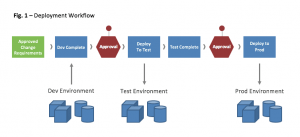The Role of IT Governance in Software Release and Deployment
By: Richard Howe
How many times have you heard about companies like the NYSE, Wall Street Journal, or United Airlines experiencing computer system outages lasting hours or days, affecting valuable end-users? Or how many times have you tried to access a web site or an application but were unsuccessful thanks to a software upgrade or modification on the current system? Could these types of issues be preventable if checkpoints or change control activities were instituted to ensure change management during the release and deployment activities? The answer is yes. In fact, with the proper governance processes in place, failed software deployment instances can be reduced significantly.
What is IT Governance?
IT Governance is the process of ensuring IT can effectively and efficiently enable an organization to achieve its goals. Every organization—large and small, public and private—needs a way to ensure that an IT function, such as release and deployment management, achieves an organization’s strategies and objectives.
The level of control you apply to IT governance may vary according to size, industry, or applicable regulations. In general, the larger and more regulated the organization, the more detailed the IT governance structure would be.
What Governance Processes are Needed for Successful Deployment or Release?
Most IT organizations typically employ “Waterfall” or “Agile” methodologies to help achieve their desired results for software implementation. These methods contain governance activities such as “Change Control Approvals” or “Testing Completion” stage gates, processes providing necessary controls that allow deployment to be managed and monitored throughout the lifecycle. As a result, the following can be achieved:
- Reduced number of incidents for unsuccessful software releases
- Reduction of implementation and maintenance costs
- Increased customer and quality satisfaction
What Applications Provide the Framework for Release Governance or Deployment Management?
HPE’s Deployment Management Module is an HPE Project and Portfolio Management Center (PPM Center) product that can manage deployment activities through governance processes to automate migration and deployment of software code, configurations, or content.
The workflow engine for the deployment management module can move released packages through required steps such as change control approvals, or testing and quality assurance, finally reaching deployment activities (see illustration).
 HPE Deployment Management Module Capabilities
HPE Deployment Management Module Capabilities
HPE’s Deployment Management can automatically deploy application components (such as XML content, HTML files, Java™ programs, and Oracle® application configurations) that each package requires. For example, HPE’s Deployment Management would connect to the development environment, copy Java files from the version control repository, and transfer the files to the quality assurance environment. It could then use the Java compiler and pack all of the files into a single Java program.
The customer can even use a built-in scheduler to schedule their deployments. HPE’s Deployment Management module maintains an audit trail for all activities, including package information, altered application components, approvals obtained, and deployments performed.
For additional information on how ResultsPositive can help provide governance for your release and deployment management activities, call us at 480-336-3450 or send an email to rpinfo@resultspositive.com and one of our representatives will promptly see to your needs.
Subscribe for the latest RP Blog Updates:

 HPE Deployment Management Module Capabilities
HPE Deployment Management Module Capabilities







